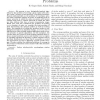Free Online Productivity Tools
i2Speak
i2Symbol
i2OCR
iTex2Img
iWeb2Print
iWeb2Shot
i2Type
iPdf2Split
iPdf2Merge
i2Bopomofo
i2Arabic
i2Style
i2Image
i2PDF
iLatex2Rtf
Sci2ools
AHSWN
2006
2006
Geometric Chemotaxis: A Biologically-Inspired Framework for a Class of Wireless Coverage Problems
Abstract-- We present a new, biologically-inspired algorithm for the problem of covering a given region with wireless "units" (sensors or base-stations). The general problem, framed mathematically as the problem of covering a polygon with a minimum number of circles, is applicable both to sensor networks in which the units are sensors with known sensing range and to wireless networks in which the units are base stations that have a known transmission range. While past work has considered the problem of locating a given number of units, we consider the joint problem of both determining the optimal number as well as locating them. Our approach to solving the problem invokes a new biological metaphor in algorithm design, chemotaxis, that is different from other biology-inspired algorithms such as neural networks or genetic algorithms. In this metaphor, the wireless units are treated as food-seeking organisms that coalesce around nutrient sources and thereby cover a region; by ca...
AHSWN 2006 | Algorithms | Base Station | Wireless |
| Added | 10 Dec 2010 |
| Updated | 10 Dec 2010 |
| Type | Journal |
| Year | 2006 |
| Where | AHSWN |
| Authors | Hidayet Ozgur Sanli, Rahul Simha, Bhagirath Narahari |
Comments (0)

